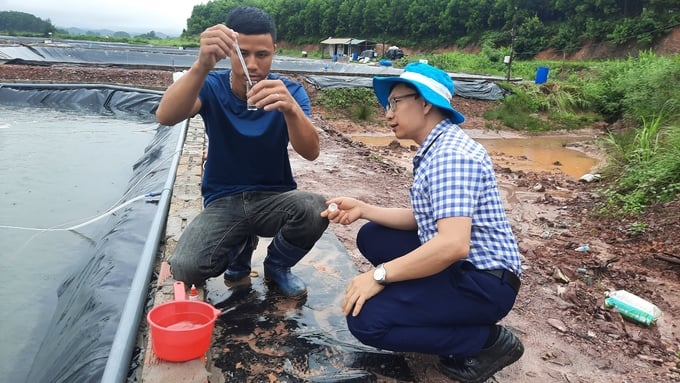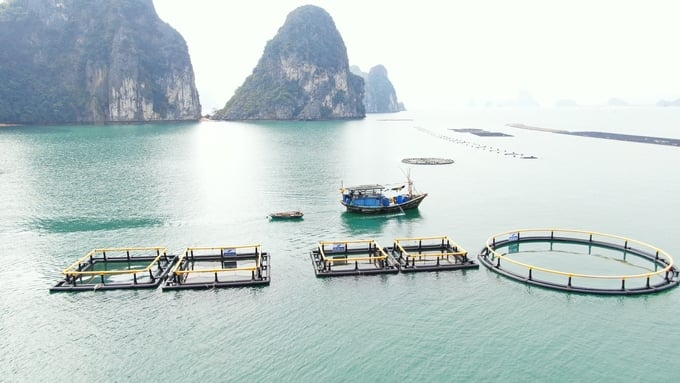May 28, 2025 | 19:31 GMT +7
May 28, 2025 | 19:31 GMT +7
Hotline: 0913.378.918
May 28, 2025 | 19:31 GMT +7
Hotline: 0913.378.918

Quang Ninh province has formed concentrated aquaculture areas with a focus on commodity production. Photo: Van Nguyen.
Quang Ninh province is currently focusing on "green" economic development targets in addition to implementing Resolution 36 on marine economic development. Fisheries is one of the six important marine economic sectors.
According to Quang Ninh province's Department of Agriculture and Rural Development, the fisheries sector is considered to be the "most accessible, sustainable and stable" thanks to its large space and room for development.
Mr. Ngo Tat Thang, Deputy Director of Quang Ninh Department of Agriculture and Rural Development, believes that water management plays a crucial role in the development aquaculture. As a result, he suggested Quang Ninh province to learn from countries with a scientific, efficient and effective water management model.
"For example, one hectare of shrimp farming water in Israel will yield approximately 150 million VND per ton of shrimp sold at the farm. Each year, that amount of water will generate at least 100 billion VND in profits, which is equivalent to 600 to 700 tons of shrimp. Comparatively, Quang Ninh province is currently farming shrimp in two to three crops, with an annual harvest of nearly 150 tons", Mr. Thang explained.
According to Mr. Ngo Tat Thang, shrimp farming in Israel is highly profitable. Furthermore, it only costs Israeli farmers approximately 90,000 VND to produce 1 kilogram of shrimp. The water source for shrimp farming in Israel is reused without being discharged into the environment, so the cost of environmental treatment is minimal.
On the other hand, Vietnamese shrimp farmers and particularly those in Quang Ninh province are only concerned with the FCR index or the amount of feed to produce 1 kilogram of shrimp meat. They often neglect the amount of water needed for 1 kilogram of shrimp as well as the amount of discharged water.
“The issue is that while shrimp farmers promote the shrimp industry, they also release water into the environment, which has an adverse impact on other industries. Because shrimp is mainly reared in coastal areas, wastewater is discharged along the shoreline, which increases the salinity of agricultural land, renders crop production difficult, and contaminates the water used for daily activities.
Poorly planned farming areas utilizes wastewater as input water, which can result in disease outbreaks and severe damage to farmers health. As a result, it is necessary to change the method of water treatment to ensure disease safety as well as increase the productivity of annual shrimp crops", Mr. Thang emphasized.

Routine water quality monitoring and inspection during shrimp farming will help ensure disease safety. Photo: Van Nguyen.
Quang Ninh province has over 50,000 hectares of water surface and coastal land area for aquaculture, including 32,000 hectares currently in use. The aquaculture area is expected to reduce to 20,000 hectares by 2030.
"Only one third of the area is used for shrimp farming; the rest is used for ancillary equipment such as water filtration and environmental treatment. Out of the total 4,000 hectares of aquaculture area in Quang Ninh province, only 2,000 hectares is required for high-tech shrimp farming following the Israeli model. Consequently, this model can help Quang Ninh produce between 600 and 800 thousand tons of shrimp per year, reaching over 30% of Vietnam's shrimp production.
With an average fresh shrimp price of 150,000 VND per kilogram, farmers can potentially earn more than 10 trillion VND or nearly 500 million USD. Quang Ninh province has the prerequisites to become the largest shrimp production center of Northern Vietnam", Mr. Thang added.
“However, Quang Ninh also has strengths in sea fish, sea snails, geoduck, sea cucumbers among many other marine species. With the help of deep processing, their values will be tripled or quadrupled within the next ten years".
According to FAO's forecast, Quang Ninh province's seafood consumption per capita will reach over 35.4 kilograms per year; the average tourist consumption will reach 0.8 kilogram per person per day. Subsequently, the total demand for seafood in Quang Ninh province will reach approximately 98 thousand tons by 2030; including 57.7 thousand tons of domestic consumption and 40,000 tons of tourist consumption.
Only 55.8% of the province's demand can be met by domestic supply, with the remaining portion being imported from other provinces or cities nationwide.
This insufficient supply requires Quang Ninh province to expand its farming area, and apply science and technology to intensive farming. Most importantly, mariculture must be efficiently planned to maximize the advantages of the fisheries sector.
Thanks to the project of converting inefficient lowland rice production area to aquaculture, many households in Quang Ninh province have achieved high economic efficiency.
The converted area in the province is estimated at nearly 3,000 hectares distributed across the towns and cities of Dong Trieu, Quang Yen, Uong Bi, Hai Ha, and Mong Cai. Most notably, Dong Trieu town has converted nearly 645 hectares in seven communes and wards (Hong Phong, Kim Son, Yen Duc, Hong Thai Tay, Hong Thai Dong, Hoang Que, and Tan Viet).
The investment in shared infrastructure within the converted areas is the combined efforts of the government and local people. Namely, projects to convert fallow and inefficient rice production area to shrimp farming in Hai Hoa ward, Mong Cai city; Song Khoai commune, Nam Hoa ward (Quang Yen) have all received investment for farming area infrastructure. Moreover, science and technology have been applied to raise economic efficiency and form concentrated farming areas with a focus on commodity production.
However, the allocation of the sea surface and the planning of the mariculture area has not been fully developed by Quang Ninh local government.
Although the government has designated his property for farming, Mr. Nguyen Xuan Hanh from Ban Sen commune in Van Don district who began farming in 2008, does not own a certificate of land use rights. According to Mr. Hanh, there are nearly 100 aquaculture households in the province; only 5% of which have a certificate of land use rights.
"The local people have been waiting for a very long time. Without a certificate of land use rights, our production is risky due to a lack of legal protection. When there is a dispute between households,the village head cannot provide help without legal basis, and when there is a natural disaster, farmers are not entitled to any relief", Mr. Hanh shared.
The potential area for mariculture in the province is estimated to be 60,740 hectares. Nearly 2,800 hectares of this area have been assigned to 13 organizations and 329 households for mariculture.
According to Mr. Do Dinh Minh, Director of the Quang Ninh Sub-Department of Fisheries, the marine spatial planning and the master plan for exploitation and sustainable use of coastal resources are not fully formed to support mariculture licensing in Quang Ninh province.
According to regulations, the water surface area within 3 nautical miles from the low tide line to the sea will be assigned and leased by the district People's Committee; the area between 3 and 6 nautical miles will be managed by the Provincial People's Committee; the area beyond 6 nautical miles will be managed by the central government. There is currently no low tide line, so it is impossible to define the level of authority who will manage, allocate and lease water surface area to organizations and individuals for mariculture.
The low tide line is usually located on the shore; however, according to the map charted by the Ministry of Natural Resources and Environment, many of these lines are inland. Quang Ninh province has only identified the low tide line on large islands including Cai Bau island in Van Don district. The five island communes of Quan Lan, Minh Chau, Thang Loi, Ngoc Vung and Ban Sen are unable to identify the low tide line and the 3 nautical mile line.

The allocation and lease of sea surface areas to individuals and organizations for mariculture is necessary. Photo: Nguyen Thanh.
Island communes such as Quan Lan, Ngoc Vung have a large population and its own government. However, they are located outside 6 nautical miles range, so the leasing of surface areas can only be performed by the Ministry, even if it is located near the shore of the island. Without surface areas, local people cannot invest in production.
Consequently, the development orientation for the fisheries sector in Quang Ninh Province from 2023 to 2030 is the legal basis for allocating and leasing mariculture area to organizations, businesses and individuals.
“The allocation and leasing of sea surface areas to individuals and organizations for mariculture is very necessary. They can limit spontaneous aquaculture, prevent the illegal use of marine resources, and promote stable development. Additionally, we must ensure effective management, promote sustainable development of fisheries, and contribute to environmental protection", emphasized Mr. Minh.
The aquaculture production area reaches over 50% of the planned aquaculture area. Shrimp farming areas are concentrated in regions between Tien Yen and Mong Cai with an area of 4,500 hectares, accounting for 56% of the total shrimp farming area. Quang Ninh province plans to uptrade Tien Yen - Dam Ha into a high-tech industrial shrimp center of Northern Vietnam with a total area of 2,000 hectares.
Translated by Nguyen Hai Long
/2025/05/25/4127-3-073637_820.jpg)
(VAN) Thanks to the promotion from an FAO-implemented project, vegetable production in greenhouses in Moc Chau has seen strong development, from 1.5 hectares in 2021 to nearly 50 hectares in 2024.

(VAN) FAO has recently supported USD 140,000 to implement the project 'Risk mitigation human-animal interface risks through disease control initiatives in pig farming.'

(VAN) The People's Committee of Tra Vinh province has approved an adjustment to the investment policy for the Green Hydrogen Plant project, increasing its area to approximately 52.76 hectares.
![Reducing emissions from rice fields: [2] Farmers’ commitment to the soil](https://t.ex-cdn.com/nongnghiepmoitruong.vn/608w/files/news/2025/05/05/dsc08881jpg-nongnghiep-140632.jpg)
(VAN) Clean rice cultivation model in Thuong Tan commune, Bac Tan Uyen district, is assisting local residents in achieving sustainable agriculture by substantially reducing costs, increasing productivity, and protecting the environment.

(VAN) At the conference to disseminate Resolution No. 68, AgriS introduced its digital agricultural ecosystem and reaffirmed its commitment to accompanying the Government in promoting private sector development and sustainable agriculture.

(VAN) 'Blue Ocean - Blue Foods' initiative is designed to restore marine ecosystems and establish sustainable livelihoods for local communities by cultivating a minimum of 1,000 hectares of cottonii seaweed in the first three years.
/2025/05/21/4642-3-112707_603.jpg)
(VAN) The V-SCOPE project has made direct contributions to three out of six pillars of the Comprehensive Strategic Partnership between Vietnam and Australia.